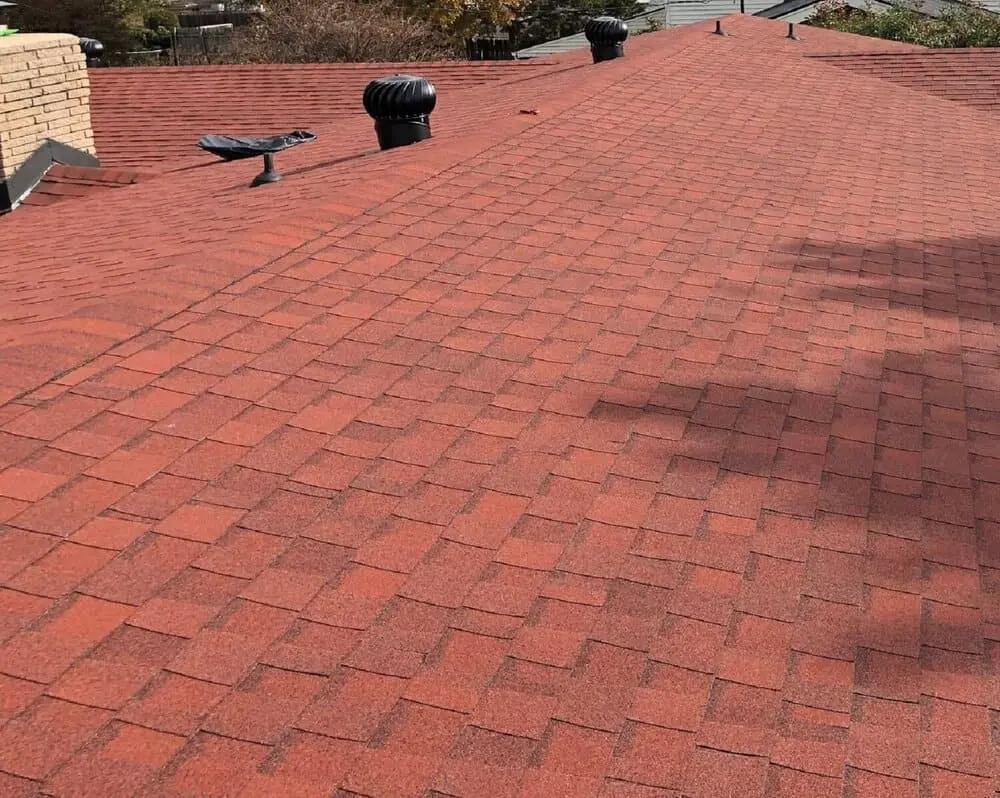
Top 5 Shingle Roof Problems and Solutions
Let’s talk about the top 5 problems with shingle roofs and their solutions.
Here are the top five:
- Easily affected by weather
- Limited installation temperatures
- Susceptibility to drying out from heat exposure
- Dark streaks known as algae stains
- Life expectancy
Easily Affected by Weather
Shingles are made to protect a home from elements such as rain and snow, but some elements work against shingles and shorten their life span. Those are extreme heat, frigid temperatures, and thunderstorms that produce high winds and hail. Hail and wind have the most extreme impact on a roof. When hail falls, it collides with the shingle, knocking the granules off or just loosening them at best. This disruption to the protective granules causes the shingle to break down from there. The wind is another force that creates problems for a roof. A person doesn’t have to drive very far to find a neighbor with a shingle or two missing from his or her roof. Don’t despair. There are solutions to these problems with shingles.
Solution
Install a shingle that can withstand the weather patterns of your geographic location. For instance, if you live in an area known for extremely high winds, choose a shingle that has a high-wind warranty. A dimensional single (also known as a laminated or an architectural shingle) has a wind rating of 110-130 mph. Avoid a 3-tab shingle, which is rated for only 60 mph winds. Additionally, if you live in an area prone to hail or that even experiences an occasional hailstorm, an impact-resistant shingle can be a great option.
Limited Installation Temperatures
The second problem with shingles is that the temperature during which they are installed should be at least 40 degrees Fahrenheit. In many areas in this country, that can mean that from January through March when temperatures rarely get above 30 degrees, installing a shingle roof would not be advisable. Installing in these cold temperatures can lead to issues over time. Shingles might blow off because they have never sealed properly as heat activates the tar strip or the shingles do not lay flat against the roof deck. When shingles are cold, they do not like to flex. When shingles come out of a package, sometimes they have a curve to them. Without heat, the shingles will not straighten out.
Solution
The best solution to cold temperature limitations is to have your roof inspected before winter. A simple roof inspection before winter can save you thousands of dollars later on by avoiding a cold-temperature installation. If temperatures are under the 40- degree mark, it is advisable to wait until temperatures warm up to maximize your new roof’s longevity.
Susceptibility to Drying Out from Heat Exposure
Heat creates problems for shingles. If the temperature outside is 90 degrees Fahrenheit with sunny skies, you can expect the surface temperature of the shingles to be an extra 40-60 degrees on top of the outside temperature, making the shingle temperature 130-150 degrees. Temperatures here in Oklahoma consistently reach and surpass the 90-degree mark all summer long. The biggest impact of heat is the combination of summer heat coupled with an attic space that is not ventilated properly. This combination over 10-15 years can cause the shingle to severe breakdown. This breakdown will manifest in the form of shingle blisters, curling on the edges, or cracking.
Solution
The best solution to this heated problem is to make sure your roof is vented properly. Contact us if you are not sure about your ventilation.
Dark Streaks Known as Algae Stains
The fourth problem associated with shingles is the horrible-looking algae stains that can develop on the roof generally 10-12 years after a shingle has been installed. Algae stains usually surface on slopes of the roof that are not exposed to the sun. Algae generally do not grow on slopes that face the sun.
Solution
Solutions are a little more limited here. Companies are starting up that specialize in the removal of algae. They spray the roof with an algae remover and then rinse the roof. A more costly solution is to replace the roof. A third option is to do nothing about the algae.
Life Expectancy
The last problem to discuss with a shingle roof is life expectancy. The day you install your new roof, the clock starts ticking on the life span of that roof. Unlike metal roofs or slate roofs that last a long time, shingle roofs are rated between 25 and 50 years. The true-life expectancy is going to be determined by such factors as proper installation, adequate ventilation, and weather events.
Solution
The best solution to this problem is choosing a shingle that will fit your geographic location. Pick a shingle that can handle the common elements associated with your region. The cost of upgrading a shingle from a “better” to “best” classification is minimal compared to replacing an entire roof well before the time you were anticipating.
